Share this

In financial services, rapid innovation is the name of the game. Competition is fierce, and it happens at the margins — when companies cannot meaningfully compete on rates, they compete on quality. Financial services organizations are working on accelerated offerings of innovative products, improving service quality and customer experience to retain existing customers and attract new customers.
This need for innovation has driven financial services companies to embrace distributed network and IT infrastructure. IT infrastructure teams are increasing workloads, shifting more workloads to the cloud, and leveraging multi/hybrid-cloud, edge, and SD-WAN strategies to enable development velocity — with the goal of delivering innovative capabilities to customers, wherever they are.
With distributed infrastructure comes increased data security challenges. In every area of financial services — banking, payments, asset management, insurance, fintech, etc. — organizations are handling large amounts of sensitive private data. For financial services companies to keep innovating responsibly, ensure customer confidence, and stay out of the news, security is and will always be a top priority.
But how can you ensure your compliance and security posture scales with your network infrastructure growth? How can your organization ensure that when various internal teams adopt a new platform, domain, or cloud provider, you can improvise security posture for the new environment as quickly as possible?
Security in a Distributed World
Security and infrastructure teams need to be able to operate across a variety of different security solutions and infrastructure domains, managing authorization, compliance, software upgrades, cyber security threat response, and audit logging across a distributed infrastructure. Financial services organizations have a wide range of critical security priorities including zero-trust architecture, segmentation and microsegmentation approaches, enabling remote workforces, and securing the underlying processes for services that are increasingly being offered to customers all over the world.
There is no one tool that does it all. Organizations need an approach that is not tied to a single tool or vendor, but rather one that enables agility when choosing new security tools, acquiring new companies, and/or switching vendors.
For mature, forward-looking organizations, designing and implementing a security posture must be tool and domain agnostic. It’s about building a robust conceptual framework—organizations are adopting principles and methodologies that can be applied to a variety of different technologies, such as zero-trust, ringfencing, etc. These principles then drive the policies, rules, and practices that are tailored to each specific tool and domain.
For instance, the infrastructure engineering and operations teams need a group of devices and tools to talk to each other regularly to enable a set of services for your developers. You are creating a fabric. Once the fabric is configured and the devices are enabled here within, the team now begins spinning up new resources and tenants for application development. If any entry points are vulnerable, then the entire fabric is vulnerable. The question now becomes, how do you limit who has access to spin up, operate on, and delete resources in this fabric?
Implementing all the right policies and reducing the attack surface as much as possible requires coordination. You might need to create a profile for an application in Zscaler, followed by also creating a security policy within your SD-WAN controller to ensure that when it comes through Zscaler, the right people have access. Then, you might need to build a security pre- or post-rule within Palo Alto to ensure that when the traffic comes through to the data center, it can securely traverse and only reach particular resources, without opening access to anything that isn’t required.
The list of actions can be much longer. But even with this small example, potentially three different teams are involved, managing three different technologies to operate infrastructure security in their own domains. Today, in almost every organization, these functions are siloed or partially siloed.
To solve this problem and quickly improvise security posture whenever adopting new technologies, financial services organizations must be able to standardize how security personnel interact with security tools across hybrid infrastructure. The right platform will be one that provides easy, rapid integration to an uneven infrastructure technology landscape which includes a mix of non-programmable resources that are CLI operated and programmable ones that are API enabled. This will allow organizations to move quickly while retaining confidence and protecting sensitive data.
Itential: Centralize Compliance & Security Posture Across a Distributed Infrastructure & the Technologies Needed to Operate It
The answer is Itential: a multi-domain platform that integrates with all infrastructure and security tools, centralizes orchestration, and allows teams to easily manage all aspects of security across a diverse toolset using a single operational layer that sits on top. Itential allows individual domains to leverage their own solutions for security, monitoring, and automation, while standardizing the way teams operate and manage workflows using these non-standard stacks. This is the future of security for financial services — a single centralized platform that standardizes inputs while allowing outputs to remain domain- and tool-specific.
Take blocking as an example — just one of many security priorities, but a critical one as organizations continue to expand their infrastructure environments and move into new domains and clouds. If a particular IP is flagged for blocking, security teams need to ensure it’s blocked across every possible entry point to the network. A couple of years ago, we partnered with a large global financial services company to enable their vision for “Blocking as a Service” across complex, distributed infrastructure. Because of Itential’s multi-domain orchestration capabilities and the ability to integrate with both CLI and API-enabled platforms, they were able to ingest alerts from multiple SOAR platforms and trigger reusable Itential workflows that would block the flagged IP/Resource across all domains and supporting technologies. This approach helped the organization accelerate their cyber security threat responses across all of infrastructure, minimizing attack vectors and ensuring nothing is forgotten due to human error. Additionally, as part of the outlined orchestration, the Itential workflow also integrated into their existing ITSM change management technology in efforts to support necessary approvals while also ensuring real time audits of all changes made to the infrastructure to secure its surfaces.
The power of a multi-domain, vendor-agnostic platform that integrates with a variety of solutions is that it enables organizations to adopt the best-fit security tooling for every piece of their infrastructure and then coordinate everything in one place. There is no vendor lock-in, and your compliance and security posture can always adapt at the speed of business, ensuring you never need to slow down in the quest for innovation.
Managing security across an uneven, distributed landscape is complex, but necessary, for modern application and feature development. Itential is the best platform on the market for financial services organizations to coordinate automation and orchestration across distributed security stacks, allowing you to manage security your way as your organization adopts new technologies and expands into new domains.
Check out this page to learn more about how Itential enables financial services organizations to accelerate and innovate securely through network orchestration.




